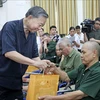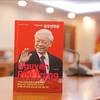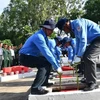Emerging from the two long and severe wars, Vietnam has developed rapidly in the national reform, people’s lives have been improved both materially and spiritually.
On the occasion of Vietnam standing for election to the UN Human Rights Council, the Vietnam News Agency introduces some articles on beliefs and religions of the Vietnamese. These articles hope to provide an accurate and updated overview of the freedom to practice one’s own beliefs in the land with a thousand-year-old culture.
Ever since the primitive time, beliefs and religions have become an inseparapable part of the Vietnamese’s spiritual life, as seen in the carving of rituals of worship on bronze drums dating back to the Dong Son civilisation (the 7 th - 1 st century BC).
By 2010, the country had 32 religious organisations whose operations were licensed by the State, with about 15.5 million followers, accounting for 18 percent of the total population. However, the number of unofficial followers is much higher, not to mention those practise folk beliefs.
Based on the number of followers, main religions in Vietnam include Buddhism, with both Mahayana and Hinayana branches with about 6.8 million followers, Catholicism (5.7 million), Hoa Hao sect (1.4 million), Cao Dai sect (808,000), Protestantism (734,000), Islam (73,000) and Balamon (56,000). There are also a wide range of folk beliefs which bear deep local characteristics and are usually mixed with another religion. Some statistics show that up to 98 percent of Vietnamese families practise some kind of worship at home.
Living for a long time in a land which is the meeting place of many big civilisations, the Vietnamese are open to receive different kinds of belief and adopt them into their own traditional spiritual activities. Cultural researcher Phan Ngoc described this phenomenon as a “refraction” of new elements based on “ Vietnam ’s cultural constant”. Beliefs and religions in Vietnam not only have a wide diversity in terms of origin, history of develpoment, and ritual forms but also have a high adaptability.
Therefore, ensuring the right to freedom of beliefs and harmony among religions has always been the most important task of the Vietnamese State, especially in the context of integration when different cultures are getting closer and closer.
During the very first meeting of the provisional Government on September 3, 1945 , only one day after the declaration of national independence, President Ho Chi Minh proposed the principle of “freedom of beliefs and solidarity between believers and non-believers”. He affirmed that the founders of great religions all shared the common purpose of upholding the good and direct people to an equal and free life and a world community. It is also the supreme goal of the Vietnamese revolution.
The very first point of view of the Ho Chi Minh era has become a guideline for the Vietnamese Party and State’s religious policy over the past seven decades, which has been emphasised at every Party Congress and stipulated in all four Constitutions.
Together with socio-economic achievements in the cause of national reform, people’s cultural life, including religious activities, have become richer and richer, from traditional rituals and festivals to international events.
The decision to stand for election to the UN Human Rights Council once again reflects Vietnam ’s strong commitment to ensuring the basic rights of people, including religious freedom, contributing to efforts to build a world of equality and happiness. -VNA
(Next episode: Worshipping the Four Immortals – Vietnam’s unique belief ).
On the occasion of Vietnam standing for election to the UN Human Rights Council, the Vietnam News Agency introduces some articles on beliefs and religions of the Vietnamese. These articles hope to provide an accurate and updated overview of the freedom to practice one’s own beliefs in the land with a thousand-year-old culture.
Ever since the primitive time, beliefs and religions have become an inseparapable part of the Vietnamese’s spiritual life, as seen in the carving of rituals of worship on bronze drums dating back to the Dong Son civilisation (the 7 th - 1 st century BC).
By 2010, the country had 32 religious organisations whose operations were licensed by the State, with about 15.5 million followers, accounting for 18 percent of the total population. However, the number of unofficial followers is much higher, not to mention those practise folk beliefs.
Based on the number of followers, main religions in Vietnam include Buddhism, with both Mahayana and Hinayana branches with about 6.8 million followers, Catholicism (5.7 million), Hoa Hao sect (1.4 million), Cao Dai sect (808,000), Protestantism (734,000), Islam (73,000) and Balamon (56,000). There are also a wide range of folk beliefs which bear deep local characteristics and are usually mixed with another religion. Some statistics show that up to 98 percent of Vietnamese families practise some kind of worship at home.
Living for a long time in a land which is the meeting place of many big civilisations, the Vietnamese are open to receive different kinds of belief and adopt them into their own traditional spiritual activities. Cultural researcher Phan Ngoc described this phenomenon as a “refraction” of new elements based on “ Vietnam ’s cultural constant”. Beliefs and religions in Vietnam not only have a wide diversity in terms of origin, history of develpoment, and ritual forms but also have a high adaptability.
Therefore, ensuring the right to freedom of beliefs and harmony among religions has always been the most important task of the Vietnamese State, especially in the context of integration when different cultures are getting closer and closer.
During the very first meeting of the provisional Government on September 3, 1945 , only one day after the declaration of national independence, President Ho Chi Minh proposed the principle of “freedom of beliefs and solidarity between believers and non-believers”. He affirmed that the founders of great religions all shared the common purpose of upholding the good and direct people to an equal and free life and a world community. It is also the supreme goal of the Vietnamese revolution.
The very first point of view of the Ho Chi Minh era has become a guideline for the Vietnamese Party and State’s religious policy over the past seven decades, which has been emphasised at every Party Congress and stipulated in all four Constitutions.
Together with socio-economic achievements in the cause of national reform, people’s cultural life, including religious activities, have become richer and richer, from traditional rituals and festivals to international events.
The decision to stand for election to the UN Human Rights Council once again reflects Vietnam ’s strong commitment to ensuring the basic rights of people, including religious freedom, contributing to efforts to build a world of equality and happiness. -VNA
(Next episode: Worshipping the Four Immortals – Vietnam’s unique belief ).



















